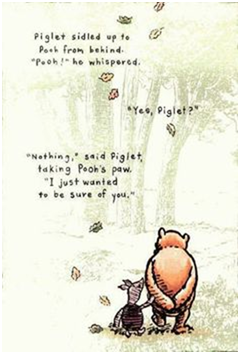Lesson 3: Attachment
Attention

Learning Outcomes
Upon completion of this lesson's material, students will be able
- Explain the importance of attachment.
- Describe ways to promote healthy attachments between themselves and child.
- Describe ways to promote healthy attachments between parent and child.
- Explain how promoting healthy attachments will create a safe and nurturing environment.
Teaching
A Little Bit of History
In 1969 psychoanalyst, John Bowlby, studied mother-infant interactions and resolved that an infant has built in mechanisms (smiling, crying and cooing) that will encourage the parent to attach and care for them. However, it was determined that the attachment process is a complex process that deepens as the infant gets older and impacts the child as they reach adulthood. The key components of attachment are: proximity maintenance, safe haven, secure base and separation distress.
The stages of attachment are:
- Preattachment (Birth to 6 weeks): An infant may be comforted by a caretakers smell and/or voice but does not discriminate between people, thus comforted being left with an unfamiliar person.
- Attachment in the making (6 weeks to 6-8 months): Attachment is built by caregivers responding and meeting the baby's basic needs for food, shelter and comfort. Infants begin to respond differently to familiar people vs. strangers but separation anxiety has not begun yet.
- Clear-cut attachment (6-8 months to 18-24 months): Separation anxiety is likely in a caregivers absence and toddlers prefer specific caregivers at times. The infant uses the trusted caregiver as a secure base in which to explore the world around them.
- Formation of reciprocal relationships (18months to 2 years and on): Toddlers now have developed a greater understanding of separation and are more confident in the caregiver's accessibility and ability to respond to their needs.
Bowlby defined, shortly thereafter, that the quality of the attachment was directly related to how the mother was responsive to her infant's needs, helping the infant established a sense of security. Generally speaking, secure attachment can be supported by timely, appropriate and consistent responses to infant cues.
Of course attachment is varied depending on each individual child characteristics and the person they form the attachment with. Derived from Mary Ainsworth's Strange Situation test, Bowlby developed three styles of attachment. Each style was concluded based on the child's general state of being, the mother's responsiveness to the infant and the fulfillment of the infant's needs. The fourth style was added by Mary Main, a colleague of Ainsworth, who also found it hard to classify some infants into one of the three categories at times.
The four styles of attachment are:
- Secure attachment – this happens when children feel confident that the attachment figure will be able to meet their needs. The caregiver is sensitive and responsive to their needs.
- Insecure avoidant attachment – this happens when children are more independent to the attachment figure physically and emotionally. The caregiver may not help during difficult tasks and is often disengaged during times of emotional distress.
- Insecure Ambivalent / Resistant attachment – this happens when children are ambivalent towards the attachment figure. They exhibit clingy and dependency to the attachment figure but rejects them when they engage in the interaction. The caregiver provides inconsistent levels of response to the child's needs and the child does not know what to expect or how to respond.
- Disorganized/Disoriented attachment – this happens when children show anger towards the attachment figure and does not want to be held or soothed. This can happen when the child suffers trauma or the attachment figure is the source of the child's stress.
Attachment as it relates to child development So what does all of this mean for us, as early childhood educators? It means that every child is different. And regardless of the attachment phase and the attachment type of the child to his parent, it is our job to create safe nurturing environments that provide opportunities for appropriate healthy, secure attachments to us, the caregivers. We also are charged with supporting healthy attachments between children and their parent(s).
Keep in mind as you work with infants who are forming attachments that each child's attachment style is specific to the attachment figure. While the child may be securely attached with one parent or caregiver, they may have an insecure/ambivalent attachment to another. While we do not know how the attachments will all shake out, the research is clear. Children perform better when they feel safe and connected. If we are shaping the brains of the future, we must pay attention to attachments and provide a safe, responsive environment that promotes secure attachments and healthy growth from one attachment phase to the next.
While reading the articles, Creating Healthy Attachments to the Babies in Your Care and Fostering Attachment in the Child Care Setting for Infants and Toddlers take note of the strategies you can use to promote healthy attachment between you and the child AND the parent and the child.
Assessment

Lesson 3 Assignment
Create an individual plan of action for the following: (there will be a total of two plans)
A – Support healthy attachments with infants and toddlers in your early childhood environment
B – Support healthy attachments between the parents and children in your early childhood environment
Each plan should consist of:
1. An introductory summary about the importance of the attachment
2. An outline of five strategies in how you will support the attachment
3. A conclusion about how your strategies will create an environment where children feel safe and connected.
You will need to submit each plan separately.
*To submit Plan of Action A, use the link in the lesson plan 3 folder labeled "Plan of Action A" (healthy attachments between you and child).
*To submit Plan of Action B, use the link labeled "Plan of Action B" (supporting healthy attachments between parent and child.)
*Each Plan of Action will be graded separately according to this rubric.